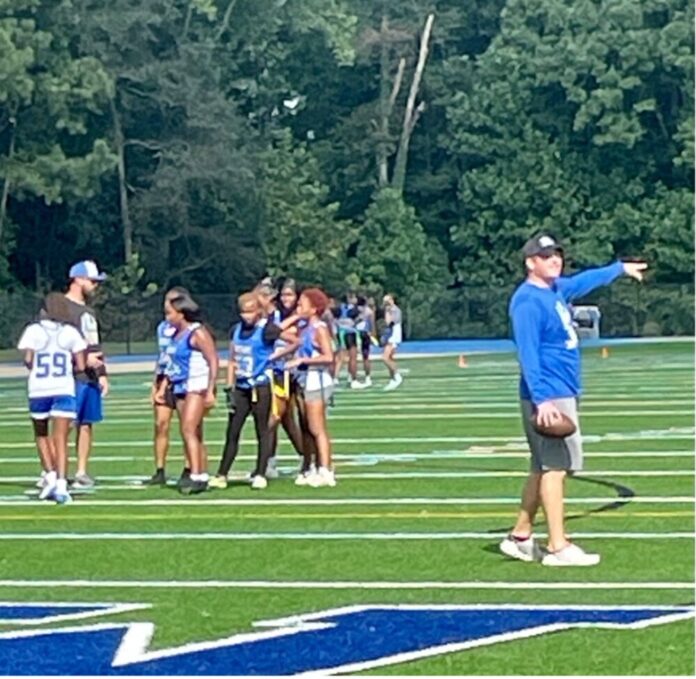
Leah Prather was no stranger to team sports. She played volleyball and softball, but when flag football came to her high school, she decided to try out for fun. This decision ended up changing her life.
Prather became one of the first women in Georgia to earn a full college scholarship as a flag football player. She is now a center for Point University in West Point, ready to help grow the sport at the collegiate level.
“I ended up falling in love with the sport, but after my senior year, I kind of figured it was just a high school thing because it really wasn’t announced that it was in colleges yet,” she said. “Then I heard that Point was having flag football, so I started kind of looking at what I would need to do for their tryouts. Then Coach Thesus Jackson said, ‘I just want to let you know that you’re going to be the first ever person to be given a scholarship through Point.’”
Flag football is one of the fastest growing sports, according to NFL Operations. Almost half a million girls between the ages of 6 and 17 played last year. The sport is sanctioned in only eight states.
Growth at the high school level
The journey to play flag football in college starts at the high school level. Jake Burgdorf, the McEachern High School flag football head coach, has been instrumental in organizing the sport at the high school level in Georgia. While the sport is only in its fourth year, 248 high schools already participate, with teams playing in all three high school divisions.
Burgdorf started the Georgia Flag Football Coaches Association to assist in the developing programs and expanding flag football to all high schools in Georgia.
“Before you know it, it’s going to be a Division I (college) sport,” he said. “Nobody knows a timeline for that, but it is headed in that direction pretty fast.”
At McEachern, almost 80 girls conditioned over the summer with hopes of trying out for the team this fall. The turnout was higher than expected considering the ideal roster would have 40 players. Flag has seven players on the field at a time, but Burgdorf wants to take as many players as possible.
“We are trying to build a program, so if a girl is athletic enough or good enough to make the team and we can develop her, then we may take a chance on somebody and keep a few more,” said Burgdorf.
The journey to flag football usually brings people who participated in other sports. For Coach Burgdorf, he made the move from tackle to flag football three years ago.
“For me it’s easier to coach girls than it is to coach boys. Girls are more coachable. They try to do what you ask them to do. They are always trying to learn and get better,” Burgdorf said.
Growth at the college level & scholarship opportunities
With the sport still in its infancy, the route to earn a college scholarship may not resemble what athletes in other sports experience. In states like Florida and Georgia, programs are funded and implemented, but in the Northeast, very few programs exist outside of intramural leagues.
Victoria Salmon played every Wednesday night on a recreational team in Massachusetts, but struggled to find a path to playing at the collegiate level. Her big break came when her travel team had the opportunity to play at the 2021 USA National Championship. There, she met coach Toni Fuller from north Georgia’s Reinhardt University.
“I was about to age out, so I was playing my last game ever. She saw me on the field and walked up and said, ‘I want to give you a full offer to come play flag football in college.’ I didn’t expect that. I cried and the video of me was everywhere. I didn’t expect that to happen,” said Salmon.
Rapid growth at the high school level is currently only taking players so far. At the collegiate and professional level, there is limited opportunity. The few opportunities at the college level are at just four schools in Georgia: Thomas University in Thomasville, Reinhardt University in Waleska, Life University in Marietta and Point University. Each plays at the National Association of Intercollegiate Athletic (NAIA) level.
But in 2025, it will expand to a Division III sport sponsored by the NCAA with more schools expected to compete.
For Prather and Salmon, they have their sights on another landmark moment in the sport. In October of this year, the International Olympic Committee voted to approve flag football as an official Olympic sport. With the support of the IOC, it will debut at the Olympic Games in Los Angeles in 2028 (LA28).
“I wanted to play football and everyone told me no,” Salmon said. “When I saw flag football, I knew I wanted to do this. I just wish people would acknowledge it. It’s still a sport. I’ve never played a sport like flag before. It’s really fun and I’ve never experienced anything like this. Just respect it like any other sport.”
For more from Fresh Take Georgia and the latest updates, follow us on Facebook and Twitter.
















